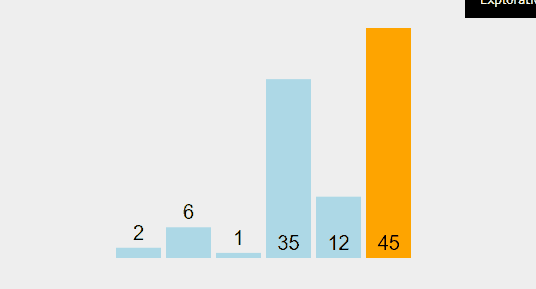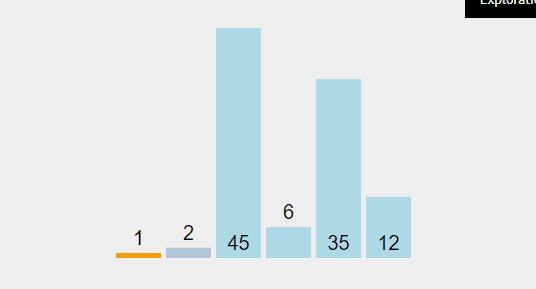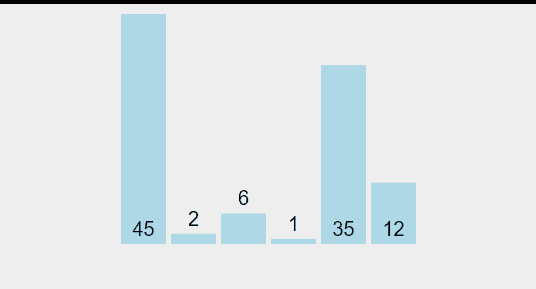JavaScript中的简单排序算法
英文 | https://medium.com/javascript-in-plain-english/simple-sorting-algorithms-in-javascript-57d512ceaf5d
翻译 | web前端开发(web_qdkf)
排序是程序员处理数据处理时最常见的问题之一。在此文中,我们将介绍一些每个程序员都应该掌握的简单排序算法。所有这些都被认为很简单,因为它们的时间复杂度均为O(n²)。如果你不清楚Big O是什么,请看我在上面写的这个文章(地址:https://medium.com/swlh/small-math-to-big-o-901a90998871)。
我还建议将TopTal的排序算法动画或Visualgo的排序部分加入书签,以便在阅读本文时可视化这些算法并在整个编程过程中提供帮助。记住,程序员最好的朋友是互联网!
交换助手方法
所有这些算法都涉及交换数组中的元素。为了更好地理解算法的工作原理,我们将抽象出一个称为“交换”的可重用函数。“交换”接收一个数组,并交换该数组的两个索引。这是JS和Ruby中的实现:
function swap (arr, index1, index2){ let temp = arr[index1]; arr[index1] = arr[index2]; arr[index2] = temp;}
冒泡排序
这些简单的排序算法中的每一个都从定义要排序的部分开始,然后从该排序的部分向外移动。冒泡排序是从找到数组中的最大值并将其移到最后一个元素(已排序的部分)开始的。然后重复执行,直到排序的部分封装了整个数组。
在上方,我们看到了冒泡排序的名称-通过不断比较两个元素并将它们交换来将最高元素冒到顶部。当数字在上面的GIF中变为橙色时,将被视为“已排序”,并且排序从头开始。然后,它将继续该过程,直到对整个数组进行排序为止。
在下面的实现中,我将跟踪两个变量-currentIndex(排序比较的对象)和endIndex(已排序的部分)。
function bubbleSort(arr){
//start the endIndex at the last index of the array
let endIndex = arr.length - 1;
//run the loop until the endIndex(sorted portion) is the 0 (the full array)
while(endIndex > 0){
// count the number of swaps to short circuit the loop if it is already sorted
let swaps = 0;
//reset the currentIndex to the beginning of the array each time a new element is sorted
let currentIndex = 0;
// loop over the array, comparing each pair of elements until the comparison element reaches the sorted portion of the array
while(currentIndex < endIndex){
// uncomment this line to see the comparison in action
// console.log(arr, arr[currentIndex], arr[currentIndex + 1])
// if the current element is greater than the element in front of it
if(arr[currentIndex] > arr[currentIndex + 1]){
//swap the 2 elements using our helper function
swap(arr, currentIndex, currentIndex + 1);
// add 1 to the swaps counter
swaps++;
}
//increase the currentIndex to continue iterating through the array
currentIndex++;
}
//stop the loop if there were no swaps because the array must be already sorted
if(swaps === 0) break;
// subtract the endIndex number to account for the new element added to the array
endIndex--;
}
return arr;
}
选择排序
选择排序基本上与冒泡排序相反。排序不是查找最大的元素并将其冒泡到顶部,而是查找数组中的最小元素并将其移动到数组的开头- 新的sorted p。然后重复执行,直到排序的部分包含整个数组。
选择排序之所以得到它的名称,是因为它遍历数组并选择最低的元素,只有在完成遍历整个数组后才交换它。
在下面的实现中,我这次将跟踪3个变量-最小的元素,要与之比较的当前元素以及已排序部分的开头。
function selectionSort(arr){
let smallestIndex = 0;
let currentIndex = 1;
let beginningIndex = 0;
//loop until the sorted p is the full array
while(beginningIndex < arr.length){
//loop over the array until the currentIndex has reached the last element
while(currentIndex < arr.length){
//keep track of the smallest index by comparing it to the current index
if(arr[smallestIndex] > arr[currentIndex]){
smallestIndex = currentIndex;
}
//add to the current index to iterate through the array
currentIndex++;
}
// after iterating through the array once, if the smallest number isn't at the sorted p, swap the two
if(smallestIndex !== beginningIndex){
swap(arr, smallestIndex, beginningIndex)
}
//add to the beginning index to incorporate the new sorted p
beginningIndex++;
//start the current index at 1 above the sorted p
currentIndex = beginningIndex + 1;
//reset the smallest index to the beginningIndex
smallestIndex = beginningIndex;
}
return arr;
}
插入排序
最后,我们到达插入排序。插入排序与我们前面讨论的前两种排序略有不同,因为它不会首先找到最高或最低的数字-它将数组中的第一个数字视为已排序,然后将数字插入到排序中。
在上面的GIF中,我们发现交换在这种情况下有点不同-我们正在交换元素的下一个索引,以便为我们要比较的当前值腾出空间-以便找到正确的位置来插入它。
在实现中,我们要跟踪三个变量-我们正在排序的部分的beginIndex,我们要检查的currentIndex和我们要比较的currentVal。
function insertionSort(arr){ let beginningIndex = 0; let currentIndex = 1; //while the start of the unsorted portion doesnt not start at the after the end of the array while(currentIndex < arr.length){ //while the currentIndex does not reach the end of the sorted p or the array (index of -1) while(currentIndex > 0){ //get currentValue(value to be sorted) currentVal = arr[currentIndex]; //if it is lesser than the last value, swap the two values, otherwise, break out of the loop if(currentVal <= arr[currentIndex - 1]){ swap(arr, currentIndex, currentIndex - 1); currentIndex--; } else{ break; }
} //add 1 to beginningIndex to account for newly sorted p beginningIndex++; //start sorting from index after beginning currentIndex = beginningIndex + 1;
}
return arr;}
请记住,这些排序算法在最坏的情况下都具有O(n²)的时间复杂度,因此如果处理大量未排序的数据,它们可能会非常慢。但是,这些算法充其量只能是O(n),因此,如果你拥有一组几乎可以排序的数据,则这些实现中的任何一种都应该可以快速运行。
如果你想查看这些用for循环编写的替代版本,请检查此Gist(地址:https://gist.github.com/Giagnus64/a1276f8b885221eedd05b79306536588)。如果你想查看这些用Ruby编写的类型,请检查此Gist(地址:https://gist.github.com/Giagnus64/d1909852e74a6df31a66d8e54655d319)。
![]()
![]()






